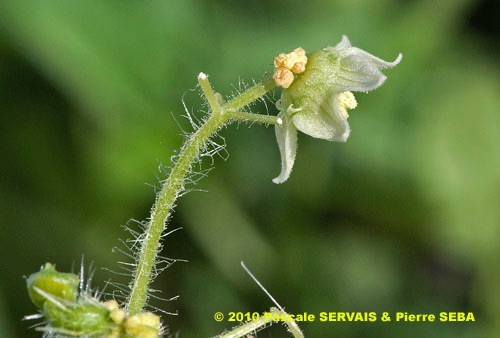
Bryonia cretica L.
Fam. : Cucurbitaceae
© Pascale SERVAIS & Pierre SEBA, 2018. Tilo Botanica: Flore de Tilos et du Dodécanèse / Flora of Tilos and of the Dodecanese
English translation by Brenda Bradbury, Howard Bradbury and Stéphane Léonard
Plante herbacée, dioïque, grimpante, à tiges dressées, très longues, couvertes de poils blancs étalés, s’accrochant aux autres plantes grâce à des vrilles spiralées simples attachées en face des feuilles.
Feuilles alternes, simples, cordiformes à palmatilobées, (de 3 à 5 lobes entiers ou à peine dentés), irrégulièrement marbrées, de 30 à 40 mm de long, poilues, longuement pétiolées.
Fleurs à symétrie radiaire, blanc jaune pâle veiné de vert, très discrètes, de 8 à 15 mm de diamètre, portées par un court pédicelle. Fleurs femelles réunies en petits bouquets latéraux de 15 à 30 mm. Fleurs mâles en grappes pendantes, sur des plantes séparées. Corolle à 5 pétales entiers, soudés à la base, plus longs que les sépales. Calice à 5 sépales verts, soudés. 1 style et 3 stigmates poilus. 3 étamines. Ovaire infère.
Fruits, baies globuleuses, vertes, marquées de blanc, virant au rouge à maturité.
___________________________
Plant herbaceous, dioecious, climbing. Stems erect, very long, covered in spread out white hairs, clinging to the other plants thanks to simple coiled tendrils attached opposite the leaves.
Leaves alternate, simple, heart-shaped to palmatilobed, (from 3 to 5 entire or scarcely toothed lobes), irregularly marbled, from 30 to 40 mm long, hairy, lengthily petiolate.
Flowers radially symmetrical, pale yellow white, with green veins, very inconspicuous, from 8 to 15 mm in diameter, carried by a short pedicel. Female flowers joined together in small lateral clusters from 15 to 30 mm. Male flowers joined together in hanging racemes, on separated plants. Corolla with 5 entire, partly fused petals, longer than the sepals. Calyx with 5 fused green sepals. 1 hairy style and 3 stigmas. 3 stamens. Ovary inferior.
Fruits, green globose berries, white-veined, becoming red at maturity.
Descripteurs / Identifying features
1
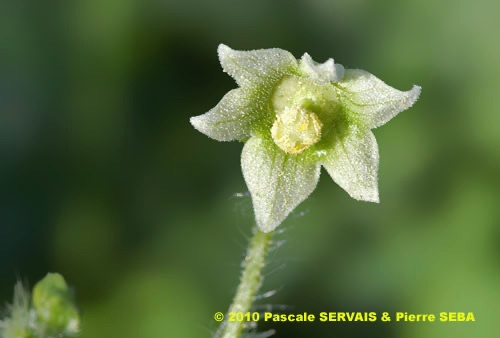
2
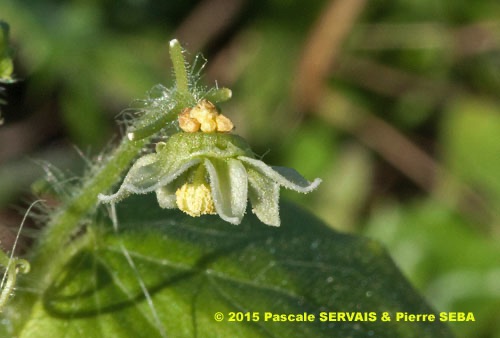
3
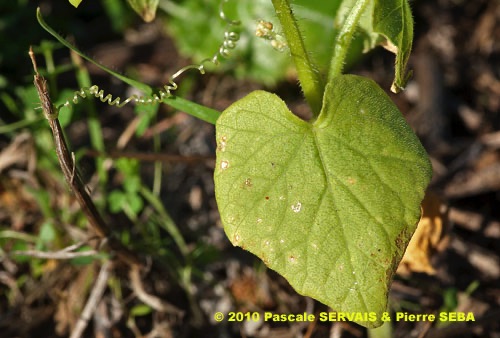
4
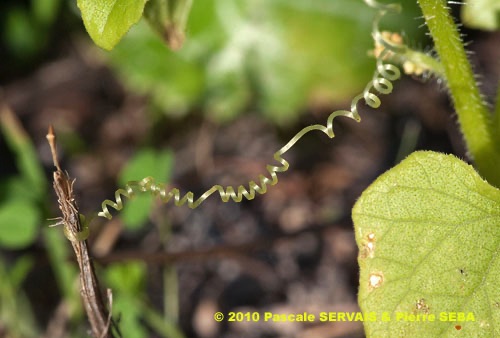
5
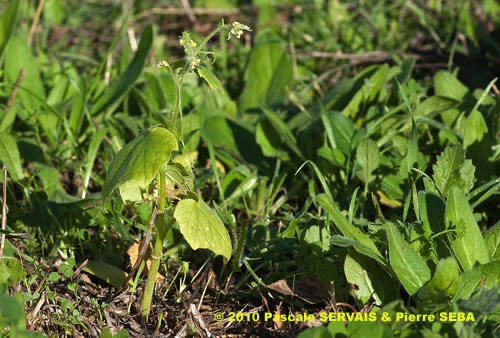
6
Étymologie / Etymology :
Bryonia : emprunt du latin bryonia, -ae (nom), nom donné à la plante
par Pline, naturaliste latin mort en 79 apr. J.-C., forme latinisée du
grec ancien βρυωνία, -ας (nom) [ < βρύω (verbe) = pousser
rapidement, croître ], nom donné à la plante par Théophraste,
philosophe péripatéticien, disciple d’Aristote, botaniste et naturaliste,
mort vers 288 av. J.-C., en référence à la croissance rapide de la
plante.
Cretica : emprunt du latin creticus, -a, -um (adj.)
[ < Creta, -ae (nom propre) = la Crète ] = de Crète, qui vient de Crète.
Bryonia : borrowed from Latin bryonia, -ae (noun), name given to
the plant by Plinius, Latin naturalist died in 79 AD, Latinized form of
the Classical Greek βρυωνία, -ας (noun) [ < βρύω (verb) = to grow
quickly ], name given to the plant by Theophrastus, peripatetic
philosopher, disciple of Aristotle, botanist and naturalist, died towards
288 BC, referring to the quick growth of the plant.
Cretica : borrowed from Latin creticus, -a, -um (adj)
[ < Creta, -ae (proper noun) = Crete ] = of or from Crete, which comes
from Crete.
Synonyme / Synonym :
—
Noms vernaculaires / Common names :
Noms français / French names :
Bryone de Crète — Fausse coloquinte — Feu-ardent — Herbe de feu —
Navet du Diable — Racine-vierge — Rave de serpent — Vigne blanche.
Noms grecs / Greek names :
Αγριοκολοκυθιά — Αμπελουρίδα — Βρυονιά — Βρυωνία η κρητική —
Θηριόχορτο — Οβρυά — Ποντικοστάφυλλο — Φαρμάκια —
Φιδοστάφυλλο ψάκομα.
Noms anglais / English names :
Aegean bryony — Cretan bryony — Death-warrant —
English mandrake — Jack-in-the-hedge — Red bryony — Tetterbury —
White bryony.
Noms allemands / German names :
Brachwurz — Kretische Zaunrübe — Rotbeerige Zaunrübe —
Rote Zaunrübe — Rotfrüchtige Zaunrübe — Zweihäusige Zaunrübe.
Noms espagnols / Spanish names :
Aquilonia — Brionia cretica.
Noms italiens / Italian names :
Brionia comune — Nueza negra — Zucca selvatica.
Habitat :
Lieux incultes - Chemins - Haies, fourrés, broussailles.
Waste ground - Waysides - Hedges, thickets.
Île / Island :
Tilos.
Hauteur / Height range :
De 20 cm à 3 m.
From 20 cm to 3 m.
Floraison / Flowering time :
De décembre à mai.
From December to May.
Groupe / Classification :
Dicotylédones.
Dicotyledons.
Pérennité / Lifespan :
Vivace.
Perennial.
Description :
Photo 1 :
Localisation / Location : Tilos, Livadia, Aghios Stephanos
Date : 07/12/2010
GPS : Lat. 36,40868° N / Long. 27,39752° E / Alt. 12 m
Type : Photographie numérique / Digital Photograph (10 mégapixels)
Photo 2 :
Localisation / Location : Tilos, Livadia, Aghios Stephanos
Date : 07/12/2010
GPS : Lat. 36,40868° N / Long. 27,39752° E / Alt. 12 m
Type : Photographie numérique / Digital Photograph (10 mégapixels)
Photo 3 :
Localisation / Location : Tilos, Livadia, Aghios Stephanos
Date : 07/12/2010
GPS : Lat. 36,40868° N / Long. 27,39752° E / Alt. 12 m
Type : Photographie numérique / Digital Photograph (10 mégapixels)
Photo 4 :
Localisation / Location : Tilos, Livadia, Aghios Stephanos
Date : 07/12/2010
GPS : Lat. 36,40868° N / Long. 27,39752° E / Alt. 12 m
Type : Photographie numérique / Digital Photograph (10 mégapixels)
Photo 5 :
Localisation / Location : Tilos, Livadia, Aghios Stephanos
Date : 07/12/2010
GPS : Lat. 36,40868° N / Long. 27,39752° E / Alt. 12 m
Type : Photographie numérique / Digital Photograph (10 mégapixels)
Photo 6 :
Localisation / Location : Tilos, Livadia, Aghios Stephanos
Date : 07/12/2010
GPS : Lat. 36,40868° N / Long. 27,39752° E / Alt. 12 m
Type : Photographie numérique / Digital Photograph (10 mégapixels)

Google Maps
Google Maps
Google Maps
Google Maps
Google Maps
Google Maps